Douglas F3D Skyknight
| F3D (F-10) Skyknight | |
|---|---|

| |
| EF-10BSkyknightof VMCJ-2Playboys | |
| Role | Fighter aircraft |
| National origin | United States |
| Manufacturer | Douglas Aircraft Company |
| First flight | 23 March 1948 |
| Introduction | 1951 |
| Retired | 1970 |
| Status | Retired |
| Primary users | United States Navy United States Marine Corps |
| Number built | 265 |
| Developed into | Douglas F6D Missileer |
TheDouglas F3D Skyknight(later redesignatedF-10 Skyknight) is an American twin-engined, mid-wingjet fighter aircraftdesigned and manufactured by theDouglas Aircraft Company.
It was designed in response to a 1945United States Navyrequirement for a jet-powered, radar-equipped, carrier-basednight fighter.Douglas designed the aircraft around the bulkyair intercept radarsystems of the era, resulting in a wide, deep, and roomy fuselage that accommodated its two-man crew. An initial contract was issued to Douglas on 3 April 1946. TheXF3D-1prototype performed itsmaiden flighton 23 March 1948. During June 1948, a production contract for 28F3D-1production aircraft was received. It was equipped with aWestinghouse AN/APQ-35fire control system,which incorporated three separate radars and was an essential component of its night fighter operations.
The F3D saw service with theUnited States NavyandUnited States Marine Corps.Its primary mission was to locate and destroy enemy aircraft at night.[1]The Skyknight was not produced in great numbers, yet it achieved numerous firsts in its role as a night fighter during theKorean War,where the type frequently escortedBoeing B-29 Superfortresseson night bombing missions. While it never achieved the fame of theNorth American F-86 Sabre,it downed several Soviet-builtMiG-15sas a night fighter over Korea. It only sustained a single air-to-air loss against aChineseMiG-15, which occurred on the night of 29 May 1953.[2][3]A total of 237 F3D-2s were completed before production was terminated on 23 March 1952.
The Skyknight played an important role in the development of the radar-guidedAIM-7 Sparrowmissile, which led to further guidedair-to-air missiledevelopments. It also served as anelectronic warfareplatform in theVietnam Waras a precursor to theEA-6A IntruderandEA-6B Prowler.The aircraft is sometimes unofficially called "Skynight", dropping the second "k". The unusual, portly profile earned it the nickname "Willie the Whale".[4]Some Vietnam WarU.S. Marineveterans have referred to the Skyknight as "Drut",whose meaning becomes obvious when read backwards. This may be in reference to its age, unflattering looks, or the low-slung air intakes that made it vulnerable toforeign object damage(FOD).[5]
Design and development[edit]
Origins[edit]
The F3D was not intended to be a typical sleek and nimble dogfighter, but as a standoff night fighter, being outfitted with a powerful radar system and a second crew member. It originated in 1945 with a US Navy requirement for a jet-powered, radar-equipped, carrier-based night fighter. The Douglas team led byEd Heinemanndesigned the aircraft around the bulkyair intercept radarsystems of the time, placing the pilot and radar operator inside-by-side seating.[6][7]The result was an aircraft with a wide, deep, and roomy fuselage. Aviation author Joe Copalman observed that the F3D was a relatively conventional aircraft, despite its use ofjet propulsion,the design team having opted for features such as a straight wing and traditional tail unit.[8]
A large and relatively flat forward windshield was used; while not conducive to high speed flight, it provided distortion-free external visibility, something that was particularly valued for a night fighter at that time.[9]The design team opted not to usetip tanksdue to the fuselage already permitting sufficient fuel capacity and the difficulty involved in properly combining the tanks with afolding wingmechanism. The use ofejection seatswas also considered but decided against as their inclusion would have necessitated a jettisonable canopy, madepressurizing the cockpitmore difficult, and added weight.[9]Instead, an escape tunnel was used, similar to the arrangement used in theDouglas A-3 Skywarrior.[6][10]The stick was extendable so that more force could be exerted upon it by the pilot as a fallback measure in the event of ahydraulicfailure.[9]
The XF3D-1 was selected over a competing submission,GrummanAircraft Engineering Corporation'sG-75twin-seat, four-engined,Westinghouse J30-powered night fighter design (similar layout to their Tigercat), leading to an initial contract being issued on 3 April 1946. The US Navy'sBureau of Aeronautics(BuAer) also issued a contract to Grumman for two G-75s (BuAer designationXF9F-1) experimental aircraft on 11 April 1946 in case the Skyknight encountered problems. Shortly thereafter, Grumman recognised that the G-75 would not be a successful aircraft, instead, the company had been working on a completely different single-engined day fighter, initially known as theG-79;it would later become theGrumman F9F Panther.[11][N 1]
Into flight[edit]
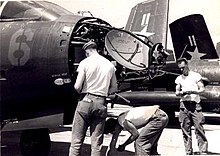
On 23 March 1948, theXF3D-1performed itsmaiden flightfrom Douglas' El Segundo facility with test pilotRussell Thawat the controls.[N 2]Whilewind tunneltesting had indicated the need for aerodynamic changes, such as the addition ofwing fences,flight testing provided these to be unnecessary.[9]Flight testing continued at El Segundo up until October 1948, after which the three prototypes were transported toMuroc Air Force Base(later renamed Edwards Air Force Base) to participate in service trials. These units were powered by a pair ofWestinghouse J34-WE-24 turbojets, capable of 3,000 lbf (13 kN) thrust, which were installed underneath therootsof then-standard straight wings of the early jet era. During June 1948, a production contract for 28F3D-1production aircraft, powered by improved J34-WE-32 engines, was issued; relatively little external changes were made between the prototype and production aircraft, save for the enlargement of the engine nacelles.[15]The first production aircraft made its first flight on 13 February 1950.[16]That same month, shore-based testing was concluded.[9]
As a night fighter that was not expected to be as fast as smaller daylight fighters, the expectation was to have a stable platform for its radar system and the four 20 mm cannon mounted in the lower fuselage. Yet, the F3D was capable of outturning aMiG-15jet fighter.[17]The fire control system in the F3D-1 was theWestinghouse AN/APQ-35.The AN/APQ-35 was advanced for the time, a combination of three different radars, each performing separate functions: an AN/APS-21 search radar, an AN/APG-26 tracking radar, both located in the nose, and an AN/APS-28 tail warning radar.[18]The AN/APS-21 was capable of detecting aircraft at distances up to 20 miles away while the AN/APG-26 could achieve a weapons lock up to 2.25 miles away and the AN/APS-28 was effective up to 10 miles away.[8][19]The complexity of thisvacuum tube-based radar system, produced before the advent ofsemiconductorelectronics, required intensive maintenance to keep it operating properly.[citation needed]
The F3D-1 was followed by theF3D-2,which was first ordered in August 1949. This model was intended to haveWestinghouse J46engines in enlarged nacelles to replace the J34-WE-32 engines of the F3D-1; however, on account of development problems with the J46, the F3D-2 was initially fitted with J34-WE-36 engines instead. Higher-thrust J34-WE-38 engines were installed later, noticeably increasing the aircraft's performance.[16]Additional changes on the F3D-2 included the incorporation of an improved Westinghouse AN/APQ-36 fire control system,autopilot,air conditioning,and abulletproofwindscreen.[20][21]A total of 237 F3D-2s were built prior to production being terminated on 23 March 1952. At one stage, a higher performanceF3D-3variant, equipped withswept wingsand J46 engines, was planned, yet work was cancelled after the J46's development was so troublesome that officials opted to terminate work.
Operational history[edit]

Korean War[edit]
The 28 F3D-1s produced were primarily used to train F3D crews, as such, this model did not see combat in theKorean War.[22]The F3D-2 Skyknight was only operated in the Korean theatre byUnited States Marine Corps(USMC) land–based squadrons, beginning in August 1952.[23][24]The first aircraft to arrive in Korea were initially unable to commence operations due to a lack of gun barrel extensions, which were necessary to safely fire the aircraft's cannons; the first aircraft to be modified was on 9 August 1952, permitting live operations to commence in the following weeks.[25]Prior to this, exercises were conducted to develop closer coordination with ground controllers, upon whom the F3D-2s were dependent upon during their night time operations.[26]
From the onset of operations, hostile jamming from inside North Korea proved to be effective against onboard radar.[27]This factor contributed to Skyknight pilots often experiencing difficulty when attempting to close in, identify, and lock onto suspected hostile aircraft. Ground-based anti-aircraft artillery, which was often equipped withradar-guidedsearch lights,proved to be more of a threat to night time operations over Korea than the occasional MiG-15; such aircraft often acted asbait,attempting to draw the Skyknights into coordinated traps.[28]According to Copalman, the AN/APS-28 tail warning radar unit proved quite advantageous in terms of situational awareness.[29]
The Skyknight was responsible for downing more enemy aircraft over Korea than any other single type of naval aircraft.[30]The first air-to-air victory was recorded on the night of 2 November 1952 by a USMC F3D-2 piloted byMajorWilliam T. Stratton Jr., and his radar operator,Master SergeantHans C. Hoglind ofVMF(N)-513Flying Nightmares,[31]Major Stratton shot down what he believed was aYakovlev Yak-15(even though no Yak-15s were reported in Korea)[5]which was the first successful night radar interception by a jet of another jet.[32]The Skyknight claimed its first MiG-15 kill on 8 November 1952, when Captain O.R. Davis andWarrant OfficerD.F. "Ding" Fessler downed a MiG-15 northwest ofPyongyang.[32]USMC pilot Lt. Joseph Corvi and his radar operator Sergeant Dan George set another record with the Skyknight on the night of 10 December 1952, when they downed the first aircraft by an aircraft with a radar track and lock-on and without visual contact. They performed the feat by using their radar to lock onto aPolikarpov Po-2biplane.They were also credited with another probable kill that night.[33]
In January 1953, the number of USMC Skyknights in Korea was doubled to 24; this increase allowed them to effectively escortB-29 Superfortresseson night bombing missions.[34][35]On 12 January 1953, an F3D-2 of VMF(N)-513 that was escorting B-29s on a night bombing mission was vectored to a contact and shot down the fourth aircraft by a Skyknight.[17]By the end of the war, Skyknights had claimed six enemy aircraft (one Polikarpov Po-2, one Yakovlev Yak-15 and four MiG-15s).[31]
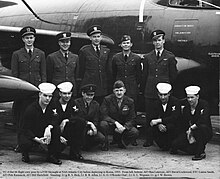

In May 1953, Composite Squadron 4 Detachment 44Nwas deployed to Korea via the U.S.S. Lake Champlain. They sailed through the Mediterranean Sea and on to the eastern Korean coast. After arriving, VC-4 flew a few patrols from the ship, but it was soon apparent that the planes were not well suited for the ships wooden deck. The exhaust nozzles on the F3D were angled slightly down and during take-off, the jet's exhaust scorched the teakwood deck of the ship. After each take-off the deck hands would rush out onto the deck and put out the smoldering fires. After several of these fire drills, the Ship's Captain insisted that VC-4 be transferred to the mainland and join up with VMF(N) 513. [36]
On 23 June 1953, VC4 (DET44N) joined with VMF(N) 513 at K-6 Airbasesouth of Seoul. The mission of VC-4 DET44N as directed by Commander Task Force NINETY-ONE and as employed as an integral part of Marine All Weather Fighter Squadron 513 based ashore, providing night fighter escort for U.S. Air Force medium bomber (B-50) strikes on targets in North Korea and providing night combat air patrols in the Chodo Island area, extending from the Haeju peninsula to the Yalu River. [37]
One F3D, piloted by LTJG Bob Bick and his RO,Chief Petty OfficerLinton Smith, was lost to enemy fire on 2 July 1953. This aircraft was part of the detachment from Fleet Composite Squadron FOUR (VC-4) atNAS Atlantic City.[38]

Operational Comments June 1953 through July 1953 The following are excerpts from Carrier Air Group FOUR, Action Report of VC-4 Detachment 44N for period 19 June 1953 to 27 July 1953.
1. The radar equipment in the F3D-2 is excellent, however the relatively low speed and slow rate of climb of the aircraft prohibits exploiting the advantage of the excellent radar coverage against high speed enemy jets.
2. The extreme visibility of the glow from the engines' tailpipes offers an easy target for a pursuer and a detriment to the evasiveness of the aircraft.
3. The near vertical forward windshield and the lack of windshield wipers, limits the visibility of the pilot, on a final GCA approach in heavy rain, to the curved side panel. Under such conditions of heavy rain, forward visibility is extremely poor. [37]
While the Skyknight lacked the swept wings and high subsonic performance of the MiG-15, its powerful fire control system enabled it to find and shoot down other fighters at night, while most MiG-15s could only be guided by ground-based radar.
Post Korean War[edit]
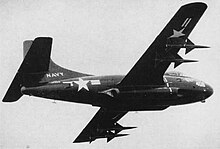
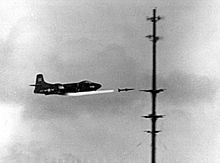
Following the Korean War, the F3D was gradually replaced by more powerful aircraft with better radar systems. Its stability and spacious fuselage made the aircraft easily adaptable to other roles. The F3D (under the designationsF3D-1MandF3D-2M) was used to support development of a number of air-to-air missile systems during the 1950s, including theSparrowI, II, and III and Meteor missiles.[39]The Sparrow missile was developed atPacific Missile Test Centerand early test firings were conducted atNaval Ordnance Test Station China Lake.During 1954, the F3D-2M became the first Navy jet aircraft to be fitted with an operational air-to-air missile, the Sparrow I,[40][41]an all weather day/nightbeyond-visual-range missilethat used beam riding guidance for the aircrew to control the missile's track. Only 28 aircraft (12 F3D-1Ms,[42]and 16 F3D-2Ms[43]) were modified to use the missiles.
In the late 1950s, a number of Marine F3D-2s were re-configured aselectronic warfareaircraft and were accordingly redesignatedF3D-2Q(laterEF-10B). Several aircraft were also converted for use as trainers and were thus redesignatedF3D-2T.Some of these aircraft were outfitted with a single 10 "photography camera, mounted in the tail section, foraerial reconnaissance.[citation needed]
During 1959, Ed Heinemann proposed that Douglas refurbish retired F3Ds for civil use, reasoning that the former military aircraft could be offered at a much lower price than newly designedbusiness jetssuch as theLockheed JetStar.Some work on the initiative was undertaken, but it was canceled after it was determined that the stored aircraft were in a generally poor condition, making their refurbishment more costly than forecast.[44]
When the U.S. Navy issued a requirement for a fleet defense missile fighter in 1959, Douglas responded with theF6D Missileer,which was essentially an updated and enlarged F3D that would carry theAAM-N-10 Eaglelong-rangeair-to-air missile,with its most important characteristics being its large fuel capacity, its considerable time-on-station, a crew of two and sophisticated electronics, rather than speed or maneuverability. This concept, which retained the straight wings in an age of supersonic combat aircraft, was soon cancelled as it was felt that the aircraft would not be able to effectively defend itself against more nimble fighters.[45][46]The supersonicGeneral Dynamics-Grumman F-111Bwas subsequently developed to carry long-range missiles, was cancelled due to excessive weight and changing tactical requirements. TheGrumman F-14 Tomcatlater entered service in this role.
Skyknights continued in service through the 1960s in a gull white color scheme, by which point many of their contemporaries had long since been retired. During 1962, at which point the U.S. Navy and U.S. Air Force unified their designation systems, the F3D-1 was redesignatedF-10Awhile the F3D-2 was redesignatedF-10B.
Vietnam War[edit]
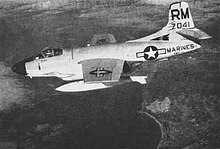
The Skyknight was the only Korean War jet fighter that also flew in Vietnam. EF-10Bs served in theElectronic warfarerole during the Vietnam War until 1969. The large interior provided ample room for electronic equipment. U.S. MarineMarine Composite Reconnaissance Squadron One (VMCJ-1)Golden Hawksbegan operating the EF-10B on 17 April 1965 under Lt. Col Wes Corman atDa Nang Air BaseRepublic of Vietnamwith six aircraft.[47]No more than 10 EF-10Bs were in Vietnam at one time. The Electronic Warfare Skyknight was a valuableElectronic countermeasureasset to jam theSA-2surface-to-air missilestracking and guidance systems.[5]VMCJ-1 made history when its EF-10Bs conducted the first USMC airborneradar jammingmission on 29 April 1965 to support aUSAFstrike mission. On 27 July 1965, four EF-10Bs also supported a massive strike on missile sites outsideHanoi.
Many U.S. aircraft were lost to SA-2s in Vietnam. The electronic attack on the associated radar systems was known as "Fogbound" missions. The F3D also dropped chaff over the radar sites.[5]The first EF-10B lost in Vietnam was to an SA-2 on 18 March 1966, while four more EF-10Bs were lost in Vietnam to accidents and unknown causes.[47]Their mission was gradually assumed by the more capable EA-6A "Electric Intruder", an Electronic Warfare/Electronic Countermeasures (EW/ECM) variant of theGrumman A-6 Intruderattack bomber.[48]The EF-10B Skyknight continued to fly lower–threat EW missions until they were withdrawn from South Vietnam in October 1969.[47]The U.S. Navy's EKA-3 Skywarrior and the USAF'sDouglas RB-66 Destroyeralso assumed electronic missions.
During May 1970, the U.S. Marine Corps retired the last of its EF-10Bs.
Post Vietnam[edit]
The U.S. Navy continued to use the F-10s foravionicssystems testing. The F-10 was used as aradartestbedto develop the APQ-72 radar. The nose of anF-4 Phantomwas added to the front of an F-10B. Another F-10 had a modifiedradomeinstalled by the radar manufacturerWestinghouse.Yet another TF-10B was modified with the nose from anA-4 Skyhawk.[49]In 1968, three Skyknights were transferred to the U.S. Army. These aircraft were operated by theRaytheonCorporation atHolloman AFBwhere they were used testing at theWhite Sands Missile Rangeinto the 1980s; they were the last flyable Skyknights.[50]
Variants[edit]
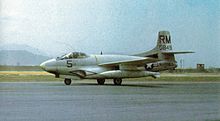

- XF3D-1
- Prototype aircraft, twoWestinghouse J34-WE-24turbojet engines of 3,000 lbf (13 kN), APQ-35 search and target acquisition radar, four 20mm cannon, three built.[16]
- F3D-1
- Two-seat all-weather day or night-fighter aircraft, powered by two 3,000 lbf (13 kN)Westinghouse J34-WE-32turbojet engines, tail warning radar, ECM, and other electronics that added over 5,000 lb (2,300 kg) of weight, 28 built. First flight: 13 February 1950.[16]
- F3D-1M
- 12 F3D-1s were converted into missile-armed test aircraft, used in the development of theAIM-7 Sparrowair-to-air missile.
- F3D-2
- Second Production version, initially powered by two 3,400 lbf (15 kN) Westinghouse J34-WE-36 and later by two 3,600 lbf (16 kN)Westinghouse J34-WE-38turbojet engines, 490 kn (560 mph; 910 km/h) at 20,000 ft (6,100 m), equipped with wing spoilers, autopilot and an improvedWestinghouse AN/APQ-36radar, 237 built. First flight: 14 February 1951.[5][16]
- F3D-2B
- One F3D-1 was used for special armament test in 1952.
- F3D-2M
- 16 F3D-2s were converted into missile armed aircraft. The F3D-2Ms were armed withAIM-7 Sparrowair-to-air missiles.
- F3D-2Q
- 35 F3D-2s were converted into electronic warfare aircraft.
- F3D-2T
- Five F3D-2s were converted into night fighter training aircraft.
- F3D-2T2
- 55 F3D-2s were used as radar-operator trainers and electronic warfare aircraft.
- F3D-3
- Unbuilt project, intended to be an advanced version incorporating swept wings.
- F-10A
- 1962 re-designation of the F3D-1.
- F-10B
- 1962 re-designation of the F3D-2.
- EF-10B
- 1962 re-designation of the F3D-2Q.
- MF-10A
- 1962 re-designation of the F3D-1M.
- MF-10B
- 1962 re-designation of the F3D-2M.
- TF-10B
- 1962 re-designation of the F3D-2T2.
Operators[edit]
Aircraft on display[edit]
- F3D-2
- BuNo 124598 –National Museum of Naval AviationatNAS Pensacola,Florida.[51]
- BuNo 124629 –Pima Air & Space Museumadjacent toDavis-Monthan AFBinTucson,Arizona.[52]
- BuNo 124630 –Flying Leatherneck Aviation MuseumatMCAS Miramar,California.[53]
- BuNo 125807 –Combat Air MuseuminTopeka, Kansas.[54]
- BuNo 125870, (repainted as BuNo 127039) – Korean War and Vietnam War memorial in Del Valle Park inLakewood, California.Originally displayed in 1950s-era dark blue coloring, the aircraft was repainted in 1963 to the grey and white color scheme of Marine Corps aircraft at the time.[55]With this repainting, the aircraft had the tail code "7L," which was the 1960s-era tail code for Marine Corps Air Reserve and Naval Air Reserve aircraft at nearbyNaval Air Station Los Alamitos,California. In 2015, the aircraft was refurbished and painted in grey and white to depict a late 1950s-era Skyknight of VMFT(N)-20 with tail code "BP."[citation needed]
- F3D-2Q
- BuNo 124618 –National Museum of the Marine Corps,inQuantico, Virginia.[56]
- BuNo 124620 –Quonset Air MuseumatQuonset State Airport(formerNAS Quonset Point) inQuonset Point,Rhode Island.[57]
- BuNo 125850 –Air Force Flight Test Center MuseumatEdwards AFB,California.This aircraft served until 1970 as part of VMCJ-3 (U.S. Marine Composite Reconnaissance Squadron 3) based atMarine Corps Air Station El Toro,California, carrying tail code "TN."[58]
- F3D-2T
- BuNo 127074 –Empire State Aerosciences Museum(ESAM) nearSchenectady,New York.[59][60]This F3D was operated byRaytheoninMassachusettsfor electronics tests until it was donated to theIntrepid Sea-Air-Space MuseuminNew York City,New York.It was displayed at the museum from 1987 until April 2012, when it was one of three aircraft moved to the ESAM to make room for theSpace Shuttle Enterprise.It is painted in the livery of U.S. Marine Night Fighter Squadron 513 (VMF(N)-513) as flown during the Korean War.[61]
Specifications (F3D-2)[edit]

Data fromMcDonnell Douglas aircraft since 1920: Volume I,[62]Standard Aircraft Characteristics: F3D-2 Skyknight[63]
General characteristics
- Crew:2
- Length:45 ft 5 in (13.84 m)
- Wingspan:50 ft 0 in (15.24 m) 26 ft 10 in (8.18 m) folded
- Height:16 ft 1 in (4.90 m) wings spread, 16 ft 6 in (5.03 m) wings folded
- Wing area:400 sq ft (37 m2)
- Aspect ratio:6.23
- Mean Aerodynamic Chord (MAC):99.8 in (2,530 mm)
- Airfoil:NACA 1412[64]
- Empty weight:14,989 lb (6,799 kg)
- Gross weight:23,575 lb (10,693 kg)
- Max takeoff weight:26,731 lb (12,125 kg)
- Maximum landing weight:24,500 lb (11,100 kg)
- Fuel capacity:1,350 US gal (1,120 imp gal; 5,100 L) maximum internal fuel and 2x 150 US gal (120 imp gal; 570 L) optional drop-tanks
- Powerplant:2 ×Westinghouse J34-WE-36turbojetengines, 3,400 lbf (15 kN) thrust each
Performance
- Maximum speed:460 kn (530 mph, 850 km/h) at 10,000 ft (3,000 m)
- Cruise speed:395 kn (455 mph, 732 km/h)
- Stall speed:80.6 kn (92.8 mph, 149.3 km/h) with approach power
- Combat range:995 nmi (1,145 mi, 1,843 km) on internals
- Ferry range:1,195 nmi (1,375 mi, 2,213 km) with 2 × 150 USgal drop-tanks
- Service ceiling:36,700 ft (11,200 m)
- g limits:+5.5 at 19,700 lb (8,900 kg)
- +5.1 at 21,374 lb (9,695 kg)
- +4 at 26,731 lb (12,125 kg)
- Rate of climb:3,570 ft/min (18.1 m/s)
- Wing loading:58.9 lb/sq ft (288 kg/m2)
- Thrust/weight:0.288
Armament
- Guns:4 × 20 mm (0.787 in)Hispano-Suiza M2cannon,200 rpg
- Rockets:2 × 11.75 in (298 mm)Tiny Timunguided rockets
- Missiles:4×Sparrow Iair-to-air missiles(F3D-2M)
- Bombs:2 × 2,000 lb (910 kg) bombs
Avionics
- AN/APQ-35A or -35B radar
- Westinghouse AN/APQ-36radar
See also[edit]
Related development
Aircraft of comparable role, configuration, and era
- Avro Canada CF-100 Canuck
- Curtiss-Wright XF-87 Blackhawk
- de Havilland Sea Venom
- de Havilland Sea Vixen
- Gloster Javelin
- Lockheed F-94 Starfire
- Northrop F-89 Scorpion
- Yakovlev Yak-25
Related lists
- List of fighter aircraft
- List of military aircraft of the United States
- List of United States Navy aircraft designations (pre-1962)
References[edit]
Notes[edit]
- ^Rather than cancel the G-75 (XF9F-1) contract, BuAer changed the wording to include three entirely different G-79 prototypes. The G-79 became the successful Grumman F9F Panther.[12][13]
- ^Russell Thaw as a test pilot for Douglas. Besides the F3D, he was responsible for many test programs, including theDouglas XB-43 JetmasterandDouglas XF4D-1 Skyray.[14]
Citations[edit]
- ^Standard Aircraft Characteristics F3D-2 SkyknightNAVAER 1335C REV. 10-51.
- ^"Defense POW/Missing Personnel Office: Korean War Air Loss Database (KORWALD)."Archived18 August 2022 at theWayback Machinedtic.mil.Retrieved: 10 August 2013.
- ^Zhang 2002, pp. 194–195.
- ^"Douglas Skyknight."Archived11 May 2008 at theWayback MachineBoeing history.Retrieved: 23 August 2010.
- ^abcdeGoebel, Greg."The Douglas F3D Skyknight."Airvectors.net,1 September 2002. Retrieved: 2 August 2013.
- ^abDonald 1997, p. 365.
- ^Thomason 2008, pp. 61-62.
- ^abCopalman 2022, p. 6.
- ^abcdeThomason 2008, p. 63.
- ^Copalman 2022, p. 12.
- ^Sullivan 1982, pp. 4, 6.
- ^Hardy 1987, p. 79.
- ^Goebel, Greg."The Grumman F9F Panther/Cougar."Airvectors,1 March 2020. Accessed 1 April 2020.
- ^"Russell William Thaw, 1910–1984."Test & Research pilots, Flight Test Engineers.Retrieved: 3 August 2013.
- ^Thomason 2008, p. 61.
- ^abcdeGunston 1981, p. 172.
- ^abDorr 1994, p. 154.
- ^Badrocke 1993, pp. 41, 44–45.
- ^Thomason 2008, pp. 61, 63.
- ^Copalman 2022, p. 7.
- ^Thomason 2008, p. 64.
- ^Thomason 2008, pp. 64-65.
- ^"SkyKnight"(PDF).Naval Aviation News. Archived fromthe original(PDF)on 3 July 1998.Retrieved2 August2013.
- ^Copalman 2022, pp. 6-8.
- ^Copalman 2022, p. 8.
- ^Copalman 2022, pp. 8-9.
- ^Copalman 2022, p. 9.
- ^Copalman 2022, pp. 10-11.
- ^Copalman 2022, pp. 11-12.
- ^"Douglas F3D-2 Sky Knight."Archived17 December 2007 at theWayback MachineFlying Leatherneck Historical Foundation and Aviation Museum.Retrieved: 16 December 2007.
- ^abGrossnick 1997, p. 768.
- ^abDorr 1994, p. 143.
- ^Dorr 1994, p. 149.
- ^Dorr 1994, p. 153.
- ^Thomason 2008, p. 66.
- ^Information conveyed to William Allen by VC4 Radar Operator AT3 Ben Latawiec in August 2020.
- ^abAddendum I Action Report of VC-4 Detachment 44N, 19 Jun 53 to 27 July 53.
- ^O'Rourke and Woodbridge 1998,[page needed].
- ^Parsch, Andreas."Raytheon AAM-N-2,3,6/AIM-101/AIM-7/RIM-7 Sparrow."Directory of U.S. Military Rockets and Missiles,2007. Retrieved: 5 August 2013.
- ^"Guided Missiles Ride Navy Jet".Popular Mechanics.Hearst Magazines. November 1954. p. 116.
- ^Thomason 2008, p. 167.
- ^Swanborough and Bowers 1976, p. 183.
- ^Swanborough and Bowers 1976, p. 182.
- ^Peter, Garrison (September 1987). "BABY BIZJET BOOM: The birth of the light jet".Flying.p. 125.
- ^Badrocke 1993, p. 47.
- ^Francillon 1979, p. 717.
- ^abcWhitten, H. Wayne, Col USMC Retired."VMCJ-1 History".Marine Corps Aviation Reconnaissance Association,June 2008. Retrieved: 8 August 2013.
- ^"Douglas F-3D-2T2 (TF-10B) Skyknight."Combat Air Museum.Retrieved: 3 August 2013.
- ^"Douglas F3D-2/F-10B Skyknight"Joseph F. Baugher.Retrieved: 19 April 2015.
- ^Yakubov, Vladimir."Douglas F3D-2N Skyknight, USS Intrepid Museum."SVSM Gallery.Retrieved: 18 August 2013.
- ^"F3D Skyknight/124598."National Museum of Naval Aviation.Retrieved: 16 January 2015.
- ^"F3D Skyknight/124629."Archived24 February 2015 at theWayback MachinePima Air & Space Museum.Retrieved: 16 January 2015.
- ^"F3D Skyknight/124630."Archived11 October 2017 at theWayback MachineFlying Leatherneck Aviation Museum.Retrieved: 16 January 2015.
- ^"F3D Skyknight/125807."Combat Air Museum.Retrieved: 21 July 2011.
- ^"F3D Skyknight/125870."aerialvisuals.caRetrieved: 8 April 2015.
- ^"F3D Skyknight/124618."aerialvisuals.caRetrieved: 16 January 2015.
- ^"F3D Skyknight/124620."Archived26 October 2016 at theWayback MachineQuonset Air Museum.Retrieved: 16 January 2015.
- ^"F3D Skyknight/125850."Archived2 January 2017 at theWayback MachineAir Force Flight Test Center MuseumRetrieved: 16 January 2015.
- ^"Final mission for fighter jets."Archived4 February 2014 at theWayback MachineSchenectady Spotlight,5 May 2012.
- ^McGeehan, Patrick."Anticipating Space Shuttle’s Arrival, Old Warplanes Ship Out."The New York Times,18 April 2012.
- ^"F3D Skyknight/127074."Archived19 December 2015 at theWayback MachineEmpire State Aerosciences Museum.Retrieved: 16 January 2015.
- ^Francillon 1988, pp. 417–424.
- ^F3D Skynight.Annapolis, US: Bureau of Aeronautics: Navy Department. January 1949. Standard Aircraft Characteristics: F3D-2 Skyknight.Retrieved12 May2019.
- ^Lednicer, David."The Incomplete Guide to Airfoil Usage".m-selig.ae.illinois.edu.Retrieved16 April2019.
Bibliography[edit]
- Andrade, John M. (1979).U.S. Military Aircraft Designations and Serials since 1909.Earl Shilton, Leicester, UK: Midland Counties Publications.ISBN0-904597-22-9.
- Badrocke, Mike (October 1993). "Electronic Warrior".Air Enthusiast(51). Stamford, UK: Key Publishing: 41–48.ISSN0143-5450.
- Copalman, Joe (2022).F3D/EF-10 Skyknight Units of the Korean and Vietnam Wars.Bloomsbury Publishing.ISBN978-1-4728-4626-6.
- Donald, David, ed. (1997).The Encyclopedia of World Aircraft.London, UK: Aerospace Publishing.ISBN1-85605-375-X.
- Dorr, Robert F; Thompson, Warren (1994).Korean Air War.St. Paul, Minnesota, US: Motorbooks International.ISBN0-879-38862-5.
- Francillon, René J. (1979).McDonnell Douglas Aircraft Since 1920.London, UK: Putnam.ISBN0-370-00050-1.
- Francillon, René J. (1988).McDonnell Douglas aircraft since 1920: Volume I.London, UK: Naval Institute Press.ISBN0-87021-428-4.
- Gunston, Bill, ed. (1981).The Illustrated History of Fighters.New York, US: Exeter Books Division of Simon & Schuster.ISBN0-89673-103-0.
- Grossnick, Roy A.; Armstrong, William J. (1997).United States Naval Aviation, 1910–1995.Annapolis, Maryland, US: Naval Historical Center.ISBN0-16-049124-X.
- Hardy, Michael John (1987).Sea, Sky and Stars: An Illustrated History of Grumman Aircraft.London, UK: Arms & Armour Press.ISBN978-0853688327.
- Heinemann, Edward H.; Rausa, Rosario (1980).Ed Heinemann: Combat Aircraft Designer.Annapolis, Maryland, US: Naval Institute Press.ISBN0-87021-797-6.
- The Illustrated Encyclopedia of Aircraft(Part Work 1982–1985).London, UK: Orbis Publishing. 1985.
- Jones, Lloyd (1975).U.S. Fighters: Army-Air Force 1925 to 1980s.Fallbrook, California, US: Aero Publishers.ISBN0-8168-9200-8.
- Jones, Lloyd (1977).U.S. Naval Fighters: 1922 to 1980s.Fallbrook, California, US: Aero Publishers.ISBN0-8168-9254-7.
- O'Rourke, G.G.; Woodbridge, E.T. (1998).Night Fighters Over Korea.Annapolis, Maryland, US: Naval Institute Press.ISBN1-55750-653-1.
- Sullivan, Jim (1982).F9F Panther/Cougar in action.Carrollton,Texas,US: Squadron/Signal Publications.ISBN0-89747-127-X.
- Swanborough, Gordon; Bowers, Peter M. (1976).United States Navy Aircraft since 1911(Second ed.). London, UK: Putnam.ISBN0370-10054-9.
- Thomason, Tommy H. (2008).U.S. Naval Air Superiority: Development of Shipborne Jet Fighters, 1943-1962.Specialty Press.ISBN978-1-58007-110-9.
